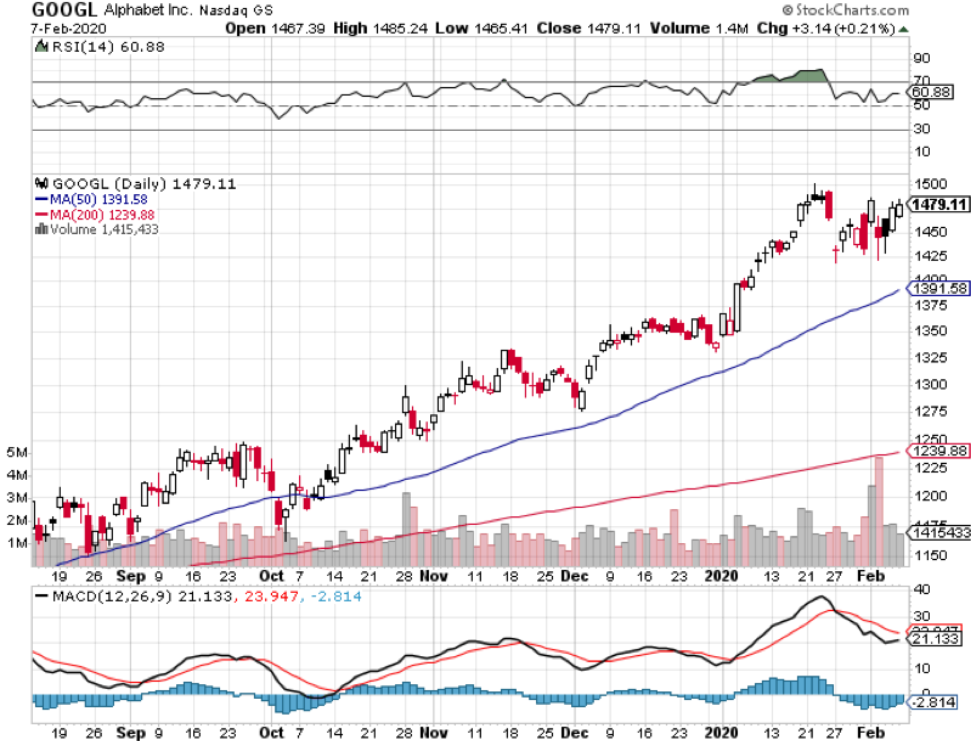In a blink of an eye – I missed my entry point again!
The earnings report gave us mixed messages, but the weakness in shares will naturally be short-lived.
Sometimes, people really forget to understand how powerful and dominant Google (GOOGL) really is.
As the stock kept running away from me and the math looked less and less appetizing, I decided to wait for the next go-around to execute a call spread on Google.
Even though sometimes Google gets slapped on the wrist for some minor blemishes on its earnings report, this time around they gave us new revenue disclosures and higher-than-expected share buybacks.
The stock cratered 2.82% to $1,440 a share in early trading last Tuesday but is still up around 25% year-over-year.
Google’s earnings per share of $15.35 was more than enough to beat expectations, but revenue was $46.08 billion, missing expectations of $46.94 billion.
Google's operating margin of 20% missed by 1%.
Google has been notoriously private about their revenue hoard but they did chime in with some more color when Google's CFO Ruth Porat, said, "to provide further insight into our business and the opportunities ahead, we’re now disclosing our revenue on a more granular basis, including for Search, YouTube ads and Cloud."
Google is still and will be at the forefront of any technological innovation of this generation buttressed by a staunch digital ad business to fund anything they want to do.
I looked into buying a call spread last Tuesday and the stock took off like a scalded chimp muddying option prices.
My big-picture thesis is unchanged, and I tell anyone and everyone in the aisles of Whole Foods to buy Google on any short-term weakness.
It’s uncanny ability to drive engagement and monetization across its 9 products with 1 billion plus users is a rare phenomenon.
Even though the law of large numbers creeps up to hurt the company, it still has strong engagement, advertiser value, and monetization possibilities.
Disclosure will give investors a more transparent way to calculate the monetization engines like Maps, Discover, and e-commerce suite of products.
What did we find out?
YouTube did $15 billion of revenue in 2019.
Google Cloud does $9 billion of annual revenue growing 50% year-over-year.
Google’s cloud business is practically the same size as Amazon Web Services (AWS) in 2016, but expanding slower than AWS did at that time.
The company has such a strong balance sheet that share repurchases were higher than expected at $6.1 billion vs. $4.0 billion.
Another sore point would be that headcount and capex in data centers, servers continue to be on the high side.
Google revealing numbers for YouTube and cloud for the first time is clearly because they felt comfortable in doing so.
I believe that they will start disclosing more detail going forward especially as the cloud division continues to ramp up and contribute meaningfully to its earnings.
And remember that it was only in July that Google said its cloud unit had just reached $8 billion in annualized revenue and planned to triple its sales force over the next few years.
Combined with installing Sundar Pichai as the new Alphabet CEO, this is a conscious move to provide more transparency to put its revenue drivers in the shop window.
Former Alphabet CEO and Google founder Larry Page and co-founder Sergey Brin stepped down from the positions last December, leaving Pichai as the big boss with power to make all game-changing decisions.
The aforementioned two still retain voting shares in the company.
The last talking point is that Google has been under intense scrutiny by federal and state regulators hoping to prove anti-competitive behavior.
A collection of 50 attorney generals from different states are investigating Google’s ad business.
But many experts believe that Google has a good chance of winning or stalling the feds, yet, the most likely outcome is that Google will be able to keep its business model but pay another massive fine which is a net positive.
Basically, Google’s narrative is intact, and any selling should be met by a wave of buying.

